The AMD Llano Notebook Review: Competing in the Mobile Market
by Jarred Walton & Anand Lal Shimpi on June 14, 2011 12:01 AM ESTBattery Life: All Day Computing
AMD makes a point of their mobile offerings (A/C/E-series APUs) all offering “all day computing”, with a note that “all day” is defined as eight hours or more. While that’s easy to do with a gigantic battery, doing so with the typical 48/56Wh batteries in mainstream laptops is a lot more difficult. One of their test notebooks apparently manages around 10.5 hours (best-case) with a 62Wh battery, compared to 6.5 hours for a similar Core i5-2410M laptop. Without specifics on all the settings, we’ll just say that our results for “similar” laptops don’t show nearly the disparity AMD achieved, but the important point is that AMD is finally competitive in battery life.
We ran our usual series of battery life tests, with the LCDs set for ~100 nits (70% brightness for the Llano laptop). We shut off WiFi for the idle test and mute audio; the Internet test is run over WiFi and repeatedly loads four tabs of content every minute, again with audio muted; finally, the H.264 playback result is done with a set of earbuds connected and WiFi disabled. Here’s how the Llano laptop stacks up to some recently reviewed laptops—you can compare Llano with other laptops in Mobile Bench.
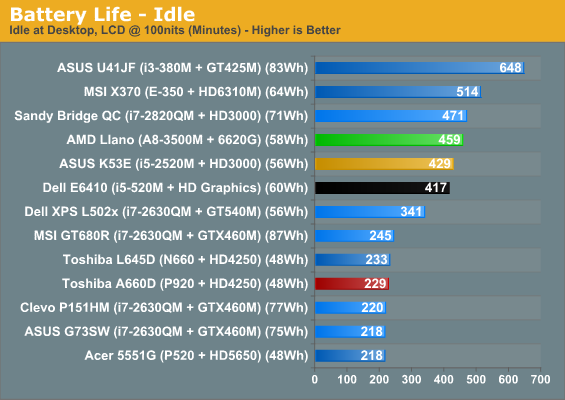

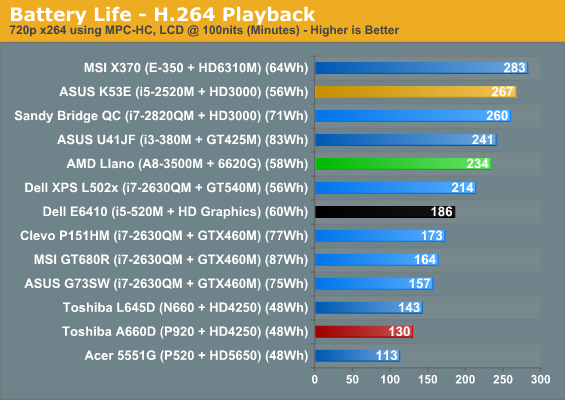
Starting with pure battery life, only three laptops consistently offer longer battery life than the Llano system: the ASUS U41JF, MSI’s X370, and the quad-core Sandy Bridge notebook. Also, the ASUS K53E boasts better battery life in the H.264 playback test, which for whatever reason is a test where SNB has proved particularly potent. Intel’s DXVA decode may be efficient, but it's also possible it's doing less work; we're running the test again with all of AMD's video enhancement features turned off. [Update: I retested with all the AMD video enhancement features disabled, and battery life didn't change, so Intel is simply more efficient at H.264 decoding with SNB.]
Back to the discussion of battery life: all three of the laptops that beat Llano have the advantage of slightly to moderately higher battery capacities, so the comparison isn’t entirely fair. Let’s level the playing field by looking at relative battery life.
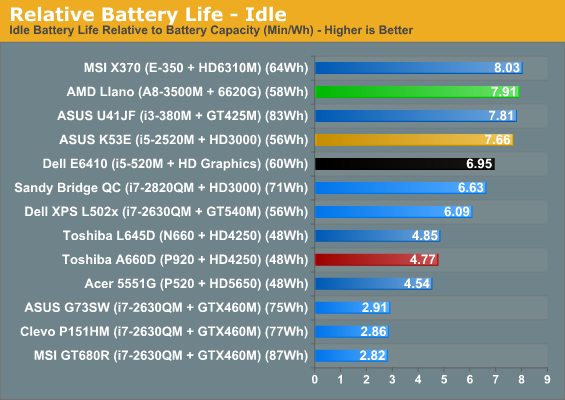
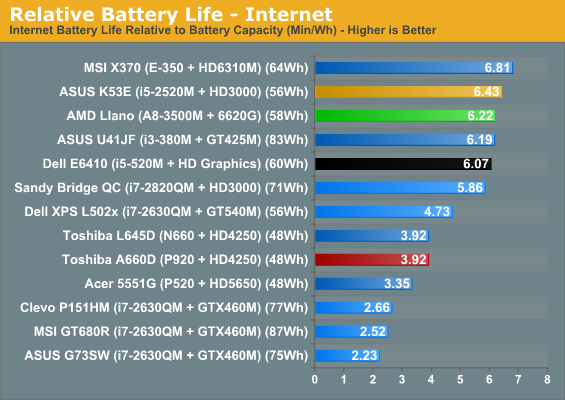
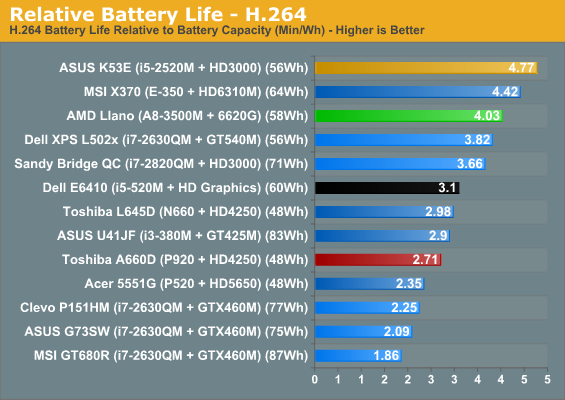
Rather amazing is that Llano actually rises to the top of the charts in the Idle test, and it’s only slightly behind the competition in the other two tests. Considering the X370 is equipped with an E-350 APU, the fact that Llano is even close is surprising. While we should note that the X370 wasn’t the most efficient of the E-350 laptops we’ve tested, we also need to point out that the 13.3” LCD is a lot closer to the 14” panel in the Llano notebook than the 11.6” panels used in the Sony YB and HP dm1z. The dual-core SNB notebook still leads in the H.264 test, and considering it has a 15.6” panel we’d say that relative battery life is very similar between the two.
We also want to talk about AMD’s claims of “all day battery life”. If we accept their definition of 8+ hours, the test laptop doesn’t actually hit that mark in our idle test. We did run the same test again at 40% LCD brightness (around 60 nits) and managed eight hours exactly, but that’s in an absolutely best-case test. For Internet surfing, which represents a more useful metric, the best way to get 8+ hours is demonstrated by ASUS’ U41JF: stuff in a higher capacity battery!
Rounding out the battery life discussion, we also tested battery life while looping 3DMark06 at native resolution (1366x768). This represents a reasonable 3D gaming scenario, and Llano still managed a reasonable 161 minutes. Considering graphics performance is a healthy step up from what Intel’s HD 3000 offers and that AMD manages double the battery life under gaming situations compared to the K53E, mobile gaming is clearly a win.
Overall, for the first time in a long time, AMD is able to offer battery life that competes with and even exceeds what Intel offers with their current mainstream offerings. There are of course a bunch of lower power Intel CPUs we could discuss, but looking at the 35W TDP parts the combination of 32nm and power gating has brought AMD back into the discussion. Even more interesting is that you should be able to get something like our test laptop for $600, possibly less, compared to dual-core SNB i5 laptops that start at $700. But then, perhaps Core i5 isn’t the best comparison for quad-core Llano, despite what AMD might like to say? Let’s move on to general performance and gaming discussions before we decide which mobile part is the “best”.










177 Comments
View All Comments
JarredWalton - Tuesday, June 14, 2011 - link
The only way to make sure that Intel's current processors aren't at the top of most charts is to leave them out, particularly on notebooks. If we only look at IGP/fGPU, AMD comes out on top of graphics charts, but is that fair to NVIDIA's Optimus technology that allows dynamic switching between IGP and dGPU in a fraction of a second? The overall tone of this article (apart from the CrossFire section) is positive, but still people look at the charts and freak out because we didn't manipulate data to make Llano look even better. It's not bad, but it's certainly not without flaws.kevith - Tuesday, June 14, 2011 - link
Oh too bad.I would like to use a laptop for music production with Nuendo and Win 7.
It actually reqires a little more graphics-musclle than you might think to run an app like Nuendo.
And,up to now, it has not been possible to get both a powerful CPU and GPU in the same machine for the money I have.
So now the fGPU is powerful enough, that's great. But it seems, that the CPU-part of these APU's are too weak.
Øv...
krumme - Tuesday, June 14, 2011 - link
ØhhhJust make sure your computer have 1Gb ram and win xp sp2, Nuendo even runs on single core 2Ghz whatever old shit.
I would save the money and buy a e350.
Heck you could even buy an Atom 510, acording to Anandtech, its just as fast as e350 for the cpu side.
When i think about it. Just do that.
ET - Tuesday, June 14, 2011 - link
As madseven7 commented correctly, this isn't the fastest Llano CPU. There are 45W parts which perform better. They will have less battery life, but a significant increase in core speed. If you're interested in Llano you might want to wait until they get reviewed.JarredWalton - Tuesday, June 14, 2011 - link
I suspect the 45W Llano parts will only have less battery life if you're specifically doing CPU/GPU intensive tasks. At idle, SNB and Llano should both bottom out at similar levels. For example, if you have a 2630QM and a 2820QM doing nothing, they both run at a very low clock and voltage. We'll test any other Llano chips we can get and report our findings, but other factors (BIOS and firmware optimizations) will generally be more important than whether the TDP is 35W or 45W, at least for our particular battery life tests.Shadowmaster625 - Tuesday, June 14, 2011 - link
I dont get the Cinebench single threaded results. An N660 is about the same as a desktop X2 250/255 on that benchmark. Yet this A83500M scores only 61% of what an X2 250 does. That would seem to indicate that it is only running at 1.8GHz during that single threaded test. Why so low with 3 idle cores? It should be running at 2.5GHz and scoring 2500, or just neck and neck with a P520. Turbo is clearly not working anywhere near as well as it should be.krumme - Tuesday, June 14, 2011 - link
Well this is AMD business at work. They are in a constant learning process and have been for the last 40 years.Next time they might consider the following:
1. Dont send some half baked prototypes to the reviewers. Wait fx. 3 more weeks. This is just old Jerry Sanders style.
2. Consider not sending stuff to Anandtech. As anandtech lives from backlinking also, the site needs the new product. And AMD, - and for the sake of the consumers right decisions, can live without 3 similar i7 plus high end discrete gfx, at 1.200 usd at the top of each chart. If AMD dont understand they have other interest than Anandtech - its business for all - they cannot serve their own interest. And its about time they start to earn their own money. They are competing against Otellini not some stupid schoolboy.
JarredWalton - Tuesday, June 14, 2011 - link
Thanks, krumme; always a helpful response. Lenovo has taken this to heart, I'm sure you'll be happy to know, and is not sending any review samples our way. Amazingly, we're still able to survive. And FWIW, if AMD hadn't sent us anything, we'd have had more content earlier through other sources. The only way they can get us to abide by NDAs is by actually working with us.krumme - Tuesday, June 14, 2011 - link
Well thank you Jarred. That was an helpfull answer! that explains a lot.I hope AMD gives you attention and work with you in the future, its in all your readers interest.
That means AMD giving you priority, broad access to the right people and more time to do the reviews.
JarredWalton - Tuesday, June 14, 2011 - link
This is something I discussed with AMD numerous times, and it's one of the reasons we want a utility that will show us true CPU clock speeds in real time. Unfortunately, they don't have anything they're willing to share with us right now. They said they have test units where they can monitor this stuff, but it requires special BIOS hooks and those are not present in our preview samples. In theory, Turbo Core should allow the single-threaded Cinebench result to run up to 60% faster than non-Turbo. Of course, we can't even disable Turbo Core either, so we don't know how much TC is actually helping.P920 is clocked 6.7% higher than A8-3500M, but 3500M has twice the L2 cache and some other enhancements. With 3500M coming in 17% faster than P920, that would suggest that 3500M averages around 1900MHz, but that could mean it runs at 2.4GHz for a bit and then 1.5GHz for a bit, or somewhere in between.
Given the way AMD does Turbo Core (monitoring instruction workloads and their relative power requirements), I think that at least right now, it's not being as aggressive as Intel's Turbo Boost. It feels more like Bloomfield and Arrandale turbo, where you got an extra 2-4 bins, rather than Sandy Bridge where you can get an extra 5-10 bins. Hopefully we'll see refinements with Turbo Core over the coming months and years.